Exploring the Spatial and Temporal Patterns of Children and Adolescents with COVID-19 Infections in Slovakia during March 2020 to July 2022
Abstract
1. Introduction
2. Materials and Methods
3. Results
3.1. Data in General
3.2. Spatiotemporal Mapping of COVID Cases
4. Discussion
5. Conclusions
Author Contributions
Funding
Institutional Review Board Statement
Informed Consent Statement
Data Availability Statement
Acknowledgments
Conflicts of Interest
Appendix A
| Age Group (Year) | ||||||||||
|---|---|---|---|---|---|---|---|---|---|---|
| Region/District | <1 | 1–4 | 5–9 | 10–14 | 15–19 | Total | Pop | Area km2 | Case/Pop % | Case/km2 |
| Banská Bystrica | 226 | 2377 | 8539 | 13,037 | 12,806 | 36,985 | 643,102 | 9450 | 5.8 | 3.91 |
| Banská Bystrica | 47 | 672 | 2287 | 3252 | 2837 | 9095 | 110,631 | 809 | 8.2 | 11.24 |
| Banská Štiavnica | 8 | 69 | 210 | 336 | 300 | 923 | 16,003 | 292 | 5.8 | 3.16 |
| Brezno | 8 | 180 | 679 | 1114 | 1123 | 3104 | 60,905 | 1265 | 5.1 | 2.45 |
| Detva | 15 | 151 | 548 | 715 | 776 | 2205 | 31,771 | 449 | 6.9 | 4.91 |
| Krupina | 9 | 96 | 279 | 434 | 505 | 1323 | 22,050 | 584 | 6.0 | 2.27 |
| Lučenec | 16 | 149 | 757 | 1289 | 1220 | 3431 | 73,071 | 825 | 4.7 | 4.16 |
| Poltár | 3 | 46 | 187 | 342 | 377 | 955 | 21,179 | 476 | 4.5 | 2.01 |
| Revúca | 8 | 64 | 255 | 475 | 588 | 1390 | 39,349 | 730 | 3.5 | 1.90 |
| Rimavská Sobota | 24 | 208 | 814 | 1351 | 1365 | 3762 | 83,953 | 1471 | 4.5 | 2.56 |
| Veľký Krtíš | 15 | 91 | 408 | 681 | 776 | 1971 | 43,002 | 848 | 4.6 | 2.32 |
| Žarnovica | 14 | 81 | 266 | 392 | 375 | 1128 | 26,054 | 425 | 4.3 | 2.65 |
| Žiar nad Hronom | 18 | 196 | 664 | 923 | 942 | 2743 | 46,477 | 517 | 5.9 | 5.31 |
| Zvolen | 41 | 374 | 1185 | 1733 | 1622 | 4955 | 68,657 | 759 | 7.2 | 6.53 |
| Bratislava | 422 | 5150 | 17,314 | 20,716 | 15,033 | 58,635 | 677,024 | 2048 | 8.7 | 28.63 |
| Bratislava | 276 | 3132 | 10,338 | 12,084 | 8794 | 34,624 | 440,948 | 365 | 7.9 | 94.86 |
| Malacky | 30 | 312 | 1429 | 2211 | 1713 | 5695 | 75,325 | 949 | 7.6 | 6.00 |
| Pezinok | 36 | 545 | 1937 | 2452 | 1806 | 6776 | 66,174 | 375 | 10.2 | 18.07 |
| Senec | 80 | 1161 | 3610 | 3969 | 2720 | 11,540 | 94,577 | 359 | 12.2 | 32.14 |
| Košice | 402 | 3532 | 11,770 | 17,543 | 16,580 | 49,827 | 802,092 | 6749 | 6.2 | 7.38 |
| Gelnica | 17 | 92 | 360 | 485 | 479 | 1433 | 31,923 | 584 | 4.5 | 2.45 |
| Košice | 145 | 1482 | 4423 | 6034 | 5407 | 17,491 | 238,138 | 241 | 7.3 | 72.58 |
| Košice—okolie | 69 | 634 | 1894 | 2878 | 2681 | 8156 | 131,305 | 1534 | 6.2 | 5.32 |
| Michalovce | 50 | 360 | 1376 | 2119 | 2043 | 5948 | 110,670 | 1019 | 5.4 | 5.84 |
| Rožňava | 14 | 145 | 653 | 1140 | 1066 | 3018 | 61,944 | 1173 | 4.9 | 2.57 |
| Sobrance | 7 | 63 | 188 | 336 | 394 | 988 | 22,775 | 538 | 4.3 | 1.84 |
| Spišská Nová Ves | 62 | 541 | 1930 | 2532 | 2216 | 7281 | 100,201 | 587 | 7.3 | 12.40 |
| Trebišov | 38 | 215 | 946 | 2019 | 2294 | 5512 | 105,136 | 1073 | 5.2 | 5.14 |
| Nitra | 260 | 2348 | 8707 | 13,262 | 12,549 | 37,126 | 671,508 | 6341 | 5.5 | 5.85 |
| Komárno | 23 | 234 | 1121 | 1906 | 1697 | 4981 | 100,992 | 1100 | 4.9 | 4.53 |
| Levice | 24 | 215 | 904 | 1541 | 1530 | 4214 | 110,040 | 1551 | 3.8 | 2.72 |
| Nitra | 102 | 925 | 3140 | 4096 | 3777 | 12,040 | 161,499 | 870 | 7.5 | 13.84 |
| Nové Zámky | 52 | 360 | 1337 | 2121 | 2097 | 5967 | 137,778 | 1347 | 4.3 | 4.43 |
| Šaľa | 14 | 245 | 817 | 1170 | 1050 | 3296 | 51,309 | 355 | 6.4 | 9.28 |
| Topoľčany | 35 | 268 | 997 | 1768 | 1749 | 4817 | 69,521 | 597 | 6.9 | 8.07 |
| Zlaté Moravce | 10 | 101 | 391 | 660 | 649 | 1811 | 40,369 | 521 | 4.5 | 3.48 |
| Prešov | 511 | 4330 | 15,160 | 21,693 | 20,683 | 62,377 | 827,028 | 8965 | 7.5 | 6.96 |
| Bardejov | 38 | 314 | 1246 | 2016 | 2198 | 5812 | 77,666 | 935 | 7.5 | 6.22 |
| Humenné | 45 | 220 | 763 | 1245 | 1268 | 3541 | 61,398 | 754 | 5.8 | 4.70 |
| Kežmarok | 28 | 265 | 1021 | 1588 | 1431 | 4333 | 76,165 | 629 | 5.7 | 6.89 |
| Levoča | 14 | 200 | 580 | 856 | 854 | 2504 | 33,730 | 421 | 7.4 | 5.95 |
| Medzilaborce | 3 | 17 | 47 | 87 | 140 | 294 | 11,708 | 427 | 2.5 | 0.69 |
| Poprad | 56 | 588 | 2237 | 2940 | 2567 | 8388 | 105,015 | 1104 | 8.0 | 7.60 |
| Prešov | 132 | 1323 | 4281 | 5300 | 4838 | 15,874 | 176,781 | 933 | 9.0 | 17.01 |
| Sabinov | 43 | 401 | 1328 | 1740 | 1542 | 5054 | 61,072 | 545 | 8.3 | 9.27 |
| Snina | 14 | 89 | 356 | 659 | 741 | 1859 | 35,833 | 804 | 5.2 | 2.31 |
| Stará Ľubovňa | 39 | 362 | 1317 | 1888 | 1694 | 5300 | 54,054 | 707 | 9.8 | 7.50 |
| Stropkov | 19 | 103 | 407 | 609 | 556 | 1694 | 20,366 | 388 | 8.3 | 4.37 |
| Svidník | 22 | 130 | 548 | 917 | 875 | 2492 | 32,334 | 549 | 7.7 | 4.54 |
| Vranov nad Topľou | 58 | 318 | 1029 | 1848 | 1979 | 5232 | 80,906 | 769 | 6.5 | 6.80 |
| Trenčín | 252 | 2969 | 11,250 | 15,735 | 14,442 | 44,648 | 582,567 | 4497 | 7.7 | 9.93 |
| Bánovce nad Bebravou | 7 | 204 | 847 | 1105 | 983 | 3146 | 35,972 | 461 | 8.7 | 6.82 |
| Ilava | 27 | 233 | 1064 | 1556 | 1380 | 4260 | 58,811 | 358 | 7.2 | 11.90 |
| Myjava | 11 | 181 | 624 | 781 | 652 | 2249 | 26,062 | 327 | 8.6 | 6.88 |
| Nové Mesto nad Váhom | 36 | 370 | 1352 | 1852 | 1585 | 5195 | 62,572 | 579 | 8.3 | 8.97 |
| Partizánske | 14 | 186 | 630 | 946 | 928 | 2704 | 45,293 | 301 | 6.0 | 8.98 |
| Považská Bystrica | 32 | 432 | 1363 | 1874 | 1787 | 5488 | 61,993 | 463 | 8.9 | 11.85 |
| Prievidza | 45 | 389 | 1453 | 2589 | 2603 | 7079 | 132,891 | 959 | 5.3 | 7.38 |
| Púchov | 34 | 239 | 949 | 1268 | 1284 | 3774 | 44,136 | 375 | 8.6 | 10.06 |
| Trenčín | 46 | 735 | 2968 | 3764 | 3240 | 10,753 | 114,837 | 674 | 9.4 | 15.95 |
| Trnava | 282 | 3207 | 12,200 | 15,927 | 13,854 | 45,470 | 565,324 | 4144 | 8.0 | 10.97 |
| Dunajská Streda | 49 | 818 | 2818 | 3536 | 2642 | 9863 | 123,355 | 1074 | 8.0 | 9.18 |
| Galanta | 41 | 385 | 1712 | 2271 | 2114 | 6523 | 94,179 | 641 | 6.9 | 10.18 |
| Hlohovec | 24 | 242 | 984 | 1290 | 1199 | 3739 | 44,731 | 267 | 8.4 | 14.00 |
| Piešťany | 47 | 448 | 1381 | 1783 | 1630 | 5289 | 62,626 | 381 | 8.4 | 13.88 |
| Senica | 30 | 324 | 1114 | 1628 | 1516 | 4612 | 60,314 | 683 | 7.6 | 6.75 |
| Skalica | 20 | 238 | 1061 | 1447 | 1301 | 4067 | 46,965 | 357 | 8.7 | 11.39 |
| Trnava | 71 | 752 | 3130 | 3972 | 3452 | 11,377 | 133,154 | 741 | 8.5 | 15.35 |
| Žilina | 464 | 3942 | 14,060 | 20,076 | 19,819 | 58,361 | 691,136 | 6802 | 8.4 | 8.58 |
| Bytča | 28 | 141 | 556 | 861 | 898 | 2484 | 31,056 | 281 | 8.0 | 8.84 |
| Čadca | 45 | 361 | 1460 | 2298 | 2716 | 6880 | 89,494 | 760 | 7.7 | 9.05 |
| Dolný Kubín | 33 | 172 | 683 | 1016 | 995 | 2899 | 39,480 | 491 | 7.3 | 5.90 |
| Kysucké Nové Mesto | 18 | 105 | 475 | 855 | 865 | 2318 | 32,890 | 173 | 7.0 | 13.40 |
| Liptovský Mikuláš | 21 | 389 | 1244 | 1824 | 1756 | 5234 | 72,054 | 1341 | 7.3 | 3.90 |
| Martin | 55 | 611 | 2326 | 2946 | 2708 | 8646 | 95,921 | 735 | 9.0 | 11.76 |
| Námestovo | 50 | 291 | 1171 | 1954 | 1950 | 5416 | 63,268 | 690 | 8.6 | 7.85 |
| Ružomberok | 32 | 298 | 1022 | 1487 | 1489 | 4328 | 56,536 | 646 | 7.7 | 6.70 |
| Turčianske Teplice | 4 | 68 | 286 | 367 | 361 | 1086 | 15,854 | 392 | 6.9 | 2.77 |
| Tvrdošín | 21 | 142 | 514 | 875 | 1003 | 2555 | 36,127 | 478 | 7.1 | 5.35 |
| Žilina | 157 | 1364 | 4323 | 5593 | 5078 | 16,515 | 158,456 | 815 | 10.4 | 20.26 |
| Grand Total | 2819 | 27,855 | 99,000 | 137,989 | 125,766 | 393,429 | 5,459,781 | 48,996 | 7.2 | 8.3 |
| Age Group (Year) | ||||||||||
|---|---|---|---|---|---|---|---|---|---|---|
| Region/District | <1 | 1–4 | 5–9 | 10–14 | 15–19 | Total | pop | Area km2 | Case/Pop % | Case/km2 |
| Banská Bystrica | 254 | 229 | 146 | 212 | 452 | 1293 | 643,102 | 9450 | 0.20 | 0.14 |
| Banská Bystrica | 206 | 193 | 128 | 181 | 170 | 878 | 110,631 | 809 | 0.79 | 1.09 |
| Brezno | 15 | 2 | 4 | 19 | 40 | 60,905 | 1265 | 0.07 | 0.03 | |
| Lučenec | 36 | 36 | 73,071 | 825 | 0.05 | 0.04 | ||||
| Revúca | 8 | 8 | 5 | 21 | 39,349 | 730 | 0.05 | 0.03 | ||
| Rimavská Sobota | 5 | 5 | 83,953 | 1471 | 0.01 | 0.00 | ||||
| Veľký Krtíš | 1 | 3 | 4 | 1 | 9 | 43,002 | 848 | 0.02 | 0.01 | |
| Žiar nad Hronom | 3 | 2 | 8 | 204 | 217 | 46,477 | 517 | 0.47 | 0.42 | |
| Zvolen | 32 | 31 | 5 | 7 | 12 | 87 | 68,657 | 759 | 0.13 | 0.11 |
| Bratislava | 746 | 1041 | 465 | 441 | 616 | 3309 | 677,024 | 2048 | 0.49 | 1.62 |
| Bratislava | 746 | 1041 | 465 | 441 | 585 | 3278 | 440,948 | 365 | 0.74 | 8.98 |
| Pezinok | 31 | 31 | 66,174 | 375 | 0.05 | 0.08 | ||||
| Košice | 1227 | 1011 | 370 | 514 | 938 | 4060 | 802,092 | 6749 | 0.51 | 0.60 |
| Košice | 879 | 785 | 306 | 410 | 662 | 3042 | 31,923 | 584 | 9.53 | 5.21 |
| Michalovce | 5 | 13 | 40 | 103 | 161 | 110,670 | 1019 | 0.15 | 0.16 | |
| Rožňava | 31 | 6 | 7 | 5 | 25 | 74 | 61,944 | 1173 | 0.12 | 0.06 |
| Spišská Nová Ves | 224 | 136 | 31 | 26 | 93 | 510 | 100,201 | 587 | 0.51 | 0.87 |
| Trebišov | 88 | 71 | 26 | 33 | 55 | 273 | 105,136 | 1073 | 0.26 | 0.25 |
| Nitra | 2443 | 242 | 103 | 74 | 219 | 3081 | 671,508 | 6341 | 0.46 | 0.49 |
| Komárno | 102 | 43 | 21 | 15 | 41 | 222 | 100,992 | 1100 | 0.22 | 0.20 |
| Levice | 67 | 131 | 17 | 6 | 51 | 272 | 110,040 | 1551 | 0.25 | 0.18 |
| Nitra | 2210 | 19 | 42 | 26 | 63 | 2360 | 161,499 | 870 | 1.46 | 2.71 |
| Nové Zámky | 8 | 8 | 137,778 | 1347 | 0.01 | 0.01 | ||||
| Topoľčany | 64 | 49 | 23 | 27 | 56 | 219 | 69,521 | 597 | 0.32 | 0.37 |
| Prešov | 1175 | 776 | 305 | 696 | 1170 | 4122 | 827,028 | 8965 | 0.50 | 0.46 |
| Bardejov | 47 | 72 | 11 | 28 | 93 | 251 | 77,666 | 935 | 0.32 | 0.27 |
| Humenné | 130 | 34 | 15 | 3 | 32 | 214 | 61,398 | 754 | 0.35 | 0.28 |
| Kežmarok | 37 | 26 | 18 | 44 | 125 | 76,165 | 629 | 0.16 | 0.20 | |
| Levoča | 3 | 3 | 33,730 | 421 | 0.01 | 0.01 | ||||
| Poprad | 172 | 207 | 130 | 145 | 185 | 839 | 105,015 | 1104 | 0.80 | 0.76 |
| Prešov | 482 | 251 | 140 | 457 | 717 | 2047 | 176,781 | 933 | 1.16 | 2.19 |
| Snina | 35 | 16 | 3 | 23 | 26 | 103 | 61,072 | 545 | 0.17 | 0.19 |
| Stará Ľubovňa | 252 | 116 | 5 | 12 | 58 | 443 | 35,833 | 804 | 1.24 | 0.55 |
| Svidník | 20 | 54 | 1 | 10 | 12 | 97 | 32,334 | 549 | 0.30 | 0.18 |
| Trenčín | 171 | 156 | 41 | 70 | 416 | 854 | 582,567 | 4497 | 0.15 | 0.19 |
| Myjava | 6 | 8 | 3 | 4 | 28 | 49 | 26,062 | 327 | 0.19 | 0.15 |
| Partizánske | 4 | 4 | 45,293 | 301 | 0.01 | 0.01 | ||||
| Považská Bystrica | 50 | 30 | 59 | 139 | 61,993 | 463 | 0.22 | 0.30 | ||
| Prievidza | 45 | 53 | 7 | 8 | 104 | 217 | 132,891 | 959 | 0.16 | 0.23 |
| Trenčín | 70 | 65 | 31 | 58 | 221 | 445 | 114,837 | 674 | 0.39 | 0.66 |
| Trnava | 154 | 171 | 57 | 67 | 126 | 575 | 565,324 | 4144 | 0.10 | 0.14 |
| Dunajská Streda | 7 | 3 | 13 | 23 | 123,355 | 1074 | 0.02 | 0.02 | ||
| Galanta | 1 | 1 | 11 | 18 | 31 | 94,179 | 641 | 0.03 | 0.05 | |
| Piešťany | 48 | 38 | 19 | 39 | 31 | 175 | 62,626 | 381 | 0.28 | 0.46 |
| Skalica | 11 | 6 | 17 | 46,965 | 357 | 0.04 | 0.05 | |||
| Trnava | 106 | 114 | 37 | 14 | 58 | 329 | 133,154 | 741 | 0.25 | 0.44 |
| Žilina | 235 | 575 | 99 | 219 | 464 | 1592 | 691,136 | 6802 | 0.23 | 0.23 |
| Čadca | 59 | 44 | 20 | 9 | 65 | 197 | 89,494 | 760 | 0.22 | 0.26 |
| Dolný Kubín | 65 | 79 | 6 | 33 | 26 | 209 | 39,480 | 491 | 0.53 | 0.43 |
| Liptovský Mikuláš | 70 | 90 | 5 | 15 | 32 | 212 | 72,054 | 1341 | 0.29 | 0.16 |
| Martin | 23 | 238 | 38 | 148 | 250 | 697 | 95,921 | 735 | 0.73 | 0.95 |
| Ružomberok | 3 | 5 | 28 | 36 | 56,536 | 646 | 0.06 | 0.06 | ||
| Tvrdošín | 18 | 121 | 30 | 9 | 37 | 215 | 36,127 | 478 | 0.60 | 0.45 |
| Žilina | 26 | 26 | 158,456 | 815 | 0.02 | 0.03 | ||||
| Grand Total | 6405 | 4201 | 1586 | 2293 | 4401 | 18,886 | 5,459,781 | 48,996 | 0.35 | 0.39 |
| Age Group (Year) | ||||||
|---|---|---|---|---|---|---|
| Region/District | <1 | 1–4 | 5–9 | 10–14 | 15–19 | Total |
| Banská Bystrica | 9 | 0 | 13 | 6 | 4 | 32 |
| Banská Bystrica | 9 | 13 | 6 | 28 | ||
| Lučenec | 4 | 4 | ||||
| Bratislava | 23 | 0 | 39 | 24 | 16 | 102 |
| Bratislava | 23 | 0 | 39 | 24 | 16 | 102 |
| Košice | 23 | 20 | 19 | 27 | 33 | 122 |
| Košice | 14 | 19 | 7 | 27 | 18 | 85 |
| Michalovce | 8 | 8 | ||||
| Spišská Nová Ves | 9 | 1 | 12 | 22 | ||
| Trebišov | 7 | 7 | ||||
| Nitra | 140 | 0 | 0 | 2 | 16 | 158 |
| Komárno | 10 | 10 | ||||
| Levice | 2 | 4 | 6 | |||
| Nitra | 140 | 140 | ||||
| Topoľčany | 2 | 2 | ||||
| Prešov | 0 | 0 | 0 | 1 | 9 | 10 |
| Bardejov | 4 | 4 | ||||
| Humenné | 1 | 1 | ||||
| Stará Ľubovňa | 5 | 5 | ||||
| Trenčín | 1 | 1 | ||||
| Myjava | 1 | 1 | ||||
| Žilina | 0 | 0 | 0 | 0 | 31 | 31 |
| Martin | 20 | 20 | ||||
| Tvrdošín | 11 | 11 | ||||
| Grand Total | 195 | 20 | 71 | 60 | 110 | 456 |
| Age Group (Year) | ||||||
|---|---|---|---|---|---|---|
| Region/District | <1 | 1–4 | 5–9 | 10–14 | 15–19 | Total |
| Banská Bystrica | 2 | 1 | 3 | |||
| Banská Bystrica | 2 | 2 | ||||
| Revúca | 1 | 1 | ||||
| Bratislava | 1 | 38 | 10 | 6 | 55 | |
| Bratislava | 1 | 38 | 10 | 6 | 55 | |
| Košice | 12 | 19 | 1 | 43 | 25 | 100 |
| Košice | 11 | 19 | 43 | 18 | 91 | |
| Spišská Nová Ves | 1 | 1 | 2 | |||
| Trebišov | 7 | 7 | ||||
| Nitra | 140 | 10 | 150 | |||
| Komárno | 6 | 6 | ||||
| Levice | 4 | 4 | ||||
| Nitra | 140 | 140 | ||||
| Prešov | 9 | 8 | 17 | |||
| Bardejov | 1 | 1 | ||||
| Humenné | 2 | 2 | ||||
| Poprad | 7 | 7 | ||||
| Snina | 7 | 7 | ||||
| Trenčín | 12 | 12 | ||||
| Myjava | 1 | 1 | ||||
| Považská Bystrica | 3 | 3 | ||||
| Trenčín | 8 | 8 | ||||
| Žilina | 46 | 22 | 68 | |||
| Čadca | 3 | 3 | ||||
| Martin | 46 | 17 | 63 | |||
| Tvrdošín | 1 | 1 | ||||
| Žilina | 1 | 1 | ||||
| Grand Total | 162 | 21 | 39 | 99 | 84 | 405 |
References
- Kang, D.; Choi, H.; Kim, J.-H.; Choi, J. Spatial epidemic dynamics of the COVID-19 outbreak in China. Int. J. Infect. Dis. 2020, 94, 96–102. [Google Scholar] [CrossRef]
- Stoecklin, S.B.; Rolland, P.; Silue, Y.; Mailles, A.; Campese, C.; Simondon, A.; Mechain, M.; Meurice, L.; Nguyen, M.; Bassi, C.; et al. First cases of coronavirus disease 2019 (COVID-19) in France: Surveillance, investigations and control measures, January 2020. Eurosurveillance 2020, 25, 2000094. [Google Scholar] [CrossRef]
- IHME-Institute for Health Metrics and Evaluation. COVID-19 Resources. 2022. Available online: http://www.healthdata.org/covid (accessed on 1 January 2022).
- WHO. WHO Coronavirus (COVID-19) Dashboard; World Health Organization: Geneva, Switzerland, 2023. [Google Scholar]
- González-Candelas, F.; Shaw, M.-A.; Phan, T.; Kulkarni-Kale, U.; Paraskevis, D.; Luciani, F.; Kimura, H.; Sironi, M. One year into the pandemic: Short-term evolution of SARS-CoV-2 and emergence of new lineages. Infect. Genet. Evol. 2021, 92, 104869. [Google Scholar] [CrossRef]
- B.1.258∆, a SARS-CoV-2 Variant with ∆H69/∆V70 in the Spike Protein Circulating in the Czech Republic and Slovakia-SARS-CoV-2 coronavirus/nCoV-2019 Genomic Epidemiology-Virological. (n.d.). Available online: https://virological.org/t/b-1-258-a-sars-cov-2-variant-with-h69-v70-in-the-spike-protein-circulating-in-the-czech-republic-and-slovakia/613 (accessed on 9 May 2024).
- De Angelis, M.; Durastanti, C.; Giovannoni, M.; Moretti, L. Spatio-temporal distribution pattern of COVID-19 in the Northern Italy during the first-wave scenario: The role of the highway network. Transp. Res. Interdiscip. Perspect. 2022, 15, 100646. [Google Scholar] [CrossRef] [PubMed]
- Grimée, M.; Dunbar, M.B.-N.; Hofmann, F.; Held, L. Modelling the effect of a border closure between Switzerland and Italy on the spatiotemporal spread of COVID-19 in Switzerland. Spat. Stat. 2022, 49, 100552. [Google Scholar] [CrossRef] [PubMed]
- Aisyah, D.N.; Mayadewi, C.A.; Diva, H.; Kozlakidis, Z.; Siswanto; Adisasmito, W. A spatial-temporal description of the SARS-CoV-2 infections in Indonesia during the first six months of outbreak. PLoS ONE 2020, 15, e0243703. [Google Scholar] [CrossRef]
- Kianfar, N.; Mesgari, M.S. GIS-based spatio-temporal analysis and modeling of COVID-19 incidence rates in Europe. Spat. Spatio-Temporal Epidemiology 2022, 41, 100498. [Google Scholar] [CrossRef]
- de Souza, A.P.G.; Mota, C.M.d.M.; Rosa, A.G.F.; de Figueiredo, C.J.J.; Candeias, A.L.B. A spatial-temporal analysis at the early stages of the COVID-19 pandemic and its determinants: The case of Recife neighborhoods, Brazil. PLoS ONE 2022, 17, e0268538. [Google Scholar] [CrossRef] [PubMed]
- Vilinová, K.; Petrikovičová, L. Spatial Autocorrelation of COVID-19 in Slovakia. Trop. Med. Infect. Dis. 2023, 8, 298. [Google Scholar] [CrossRef]
- Jamal, S.; Paez, A. Socio-economic and demographic differences in the impact of COVID-19 on personal travel in the Global South. Transp. Rev. 2024, 44, 272–298. [Google Scholar] [CrossRef]
- Zoungrana, T.D.; Yerbanga, A.; Ouoba, Y. Socio-economic and environmental factors in the global spread of COVID-19 outbreak. Res. Econ. 2022, 76, 325–344. [Google Scholar] [CrossRef] [PubMed]
- Kwok, C.Y.T.; Wong, M.S.; Chan, K.L.; Kwan, M.-P.; Nichol, J.E.; Liu, C.H.; Wong, J.Y.H.; Wai, A.K.C.; Chan, L.W.C.; Xu, Y.; et al. Spatial analysis of the impact of urban geometry and socio-demographic characteristics on COVID-19, a study in Hong Kong. Sci. Total. Environ. 2021, 764, 144455. [Google Scholar] [CrossRef] [PubMed]
- Vega-Gonzalo, M.; Gomez, J.; Christidis, P. How has COVID-19 changed private car use in European urban areas? An analysis of the effect of socio-economic characteristics and mobility habits. Transp. Res. Part A Policy Pract. 2023, 172, 103679. [Google Scholar] [CrossRef] [PubMed]
- Irawan, M.Z.; Rizki, M.; Joewono, T.B.; Belgiawan, P.F. Exploring the intention of out-of-home activities participation during new normal conditions in Indonesian cities. Transp. Res. Interdiscip. Perspect. 2020, 8, 100237. [Google Scholar] [CrossRef] [PubMed]
- Kim, J.K.; Crimmins, E.M. How does age affect personal and social reactions to COVID-19: Results from the national Understanding America Study. PLoS ONE 2020, 15, e0241950. [Google Scholar] [CrossRef] [PubMed]
- Chen, T.; Lucock, M. The mental health of university students during the COVID-19 pandemic: An online survey in the UK. PLoS ONE 2022, 17, e0262562. [Google Scholar] [CrossRef] [PubMed]
- Magson, N.R.; Freeman, J.Y.A.; Rapee, R.M.; Richardson, C.E.; Oar, E.L.; Fardouly, J. Risk and Protective Factors for Prospective Changes in Adolescent Mental Health during the COVID-19 Pandemic. J. Youth Adolesc. 2021, 50, 44–57. [Google Scholar] [CrossRef] [PubMed]
- Snape, M.D.; Viner, R.M. COVID-19 in children and young people. Science 2020, 370, 286–288. [Google Scholar] [CrossRef] [PubMed]
- Andrews, M.R.; Tamura, K.; Best, J.N.; Ceasar, J.N.; Batey, K.G.; Kearse, T.A.; Allen, L.V.; Baumer, Y.; Collins, B.S.; Mitchell, V.M.; et al. Spatial Clustering of County-Level COVID-19 Rates in the U.S. Int. J. Environ. Res. Public Health 2021, 18, 12170. [Google Scholar] [CrossRef]
- Ficetola, G.F.; Rubolini, D. Containment measures limit environmental effects on COVID-19 early outbreak dynamics. Sci. Total. Environ. 2021, 761, 144432. [Google Scholar] [CrossRef]
- Zhang, X.; Smith, N.; Spear, E.; Stroustrup, A. Neighborhood characteristics associated with COVID-19 burden-the modifying effect of age. J. Expo. Sci. Environ. Epidemiology 2021, 31, 525–537. [Google Scholar] [CrossRef] [PubMed]
- Rahman, H.; Zafri, N.M.; Ashik, F.R.; Waliullah; Khan, A. Identification of risk factors contributing to COVID-19 incidence rates in Bangladesh: A GIS-based spatial modeling approach. Heliyon 2021, 7, e06260. [Google Scholar] [CrossRef] [PubMed]
- Dowd, J.B.; Andriano, L.; Brazel, D.M.; Rotondi, V.; Block, P.; Ding, X.; Liu, Y.; Mills, M.C. Demographic science aids in understanding the spread and fatality rates of COVID-19. Proc. Natl. Acad. Sci. USA 2020, 117, 9696–9698. [Google Scholar] [CrossRef] [PubMed]
- Sannigrahi, S.; Pilla, F.; Basu, B.; Basu, A.S.; Molter, A. Examining the association between socio-demographic composition and COVID-19 fatalities in the European region using spatial regression approach. Sustain. Cities Soc. 2020, 62, 102418. [Google Scholar] [CrossRef] [PubMed]
- Olds, P.K.; Musinguzi, N.; Geisler, B.P.; Haberer, J.E. Evaluating disparities by social determinants in hospital admission decisions for patients with COVID-19 quaternary hospital early in the pandemic. Medicine 2023, 102, e33178. [Google Scholar] [CrossRef]
- Assefa, Y.; Gilks, C.F.; Reid, S.; van de Pas, R.; Gete, D.G.; Van Damme, W. Analysis of the COVID-19 pandemic: Lessons towards a more effective response to public health emergencies. Glob. Health 2022, 18, 10. [Google Scholar] [CrossRef]
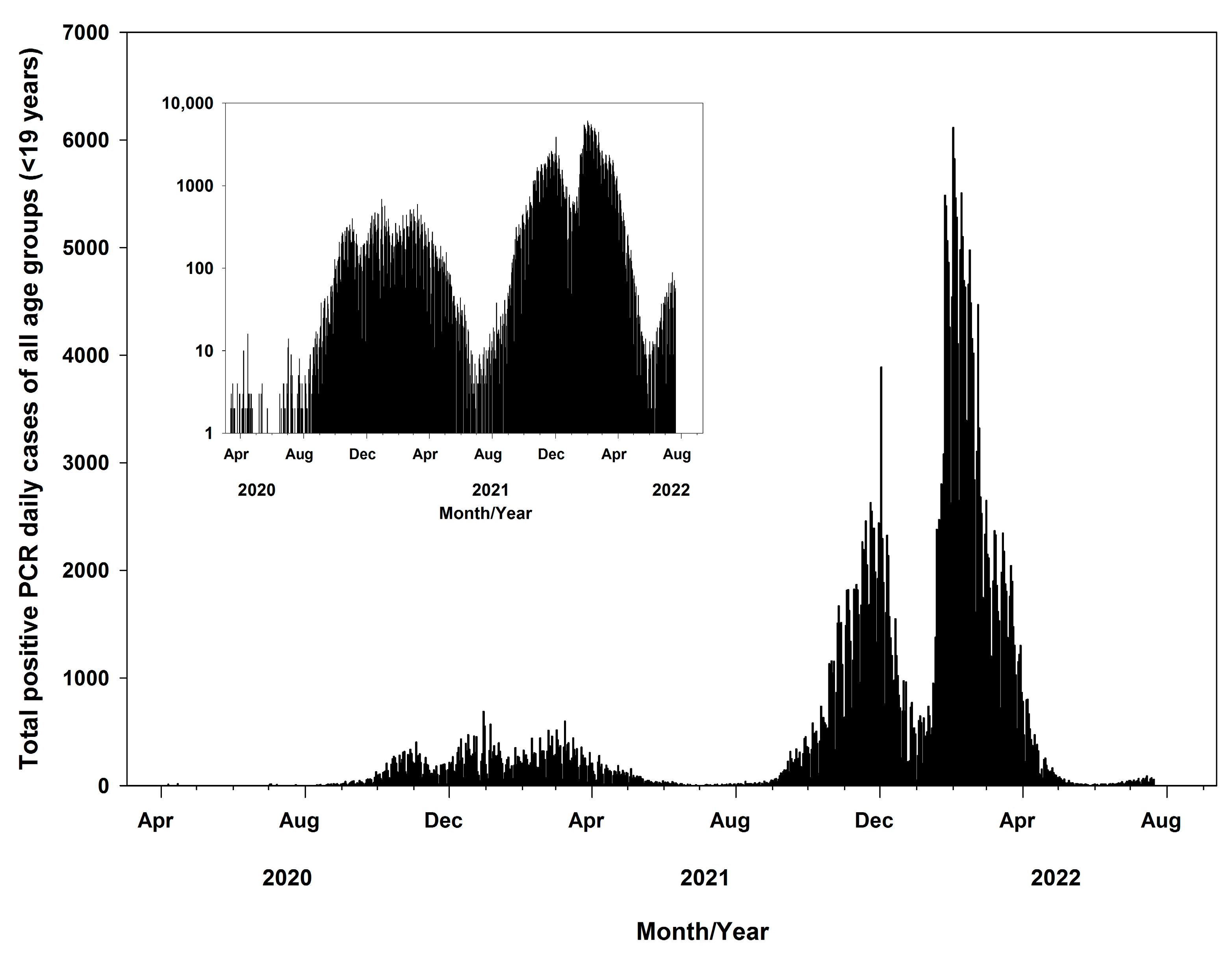
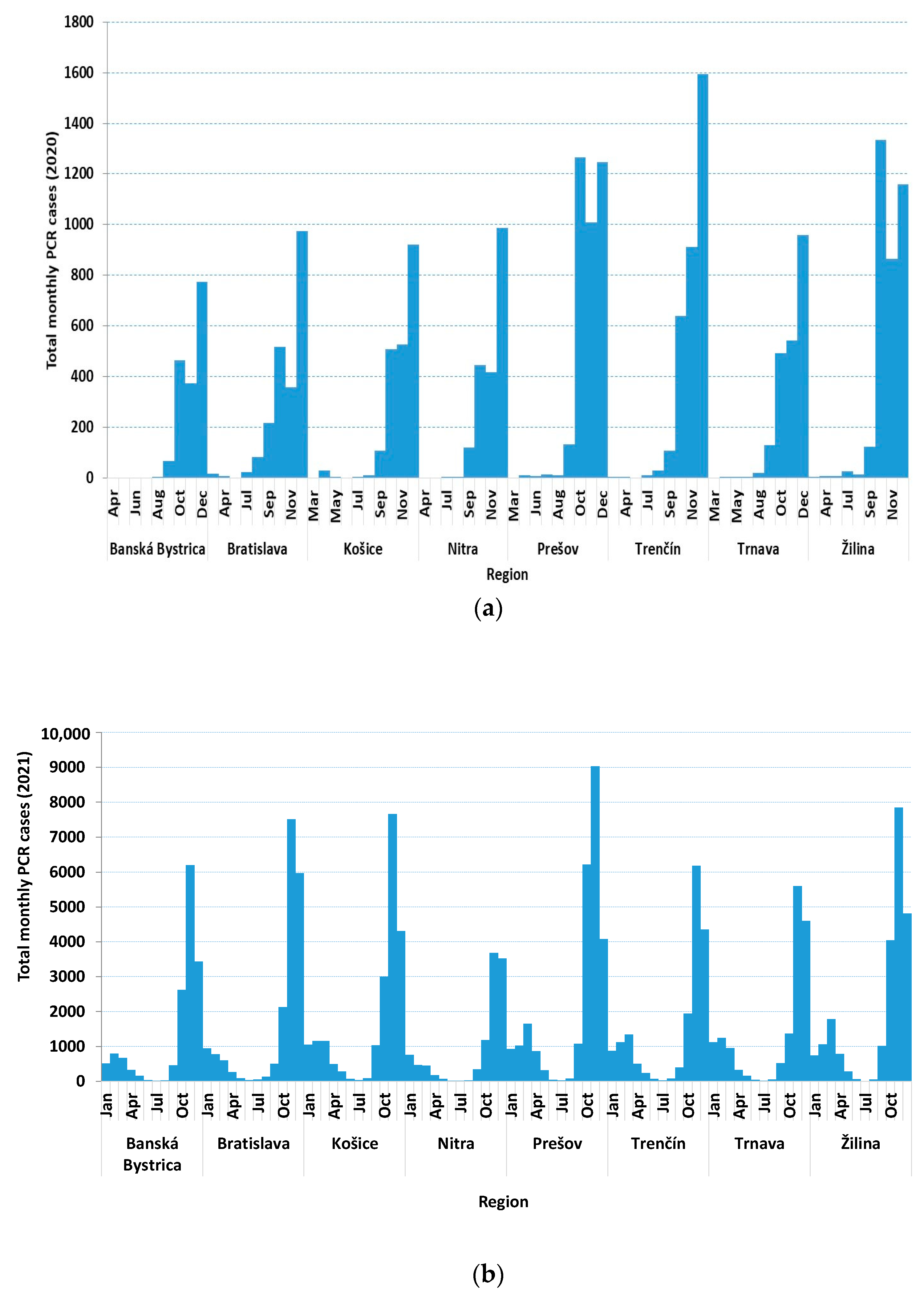
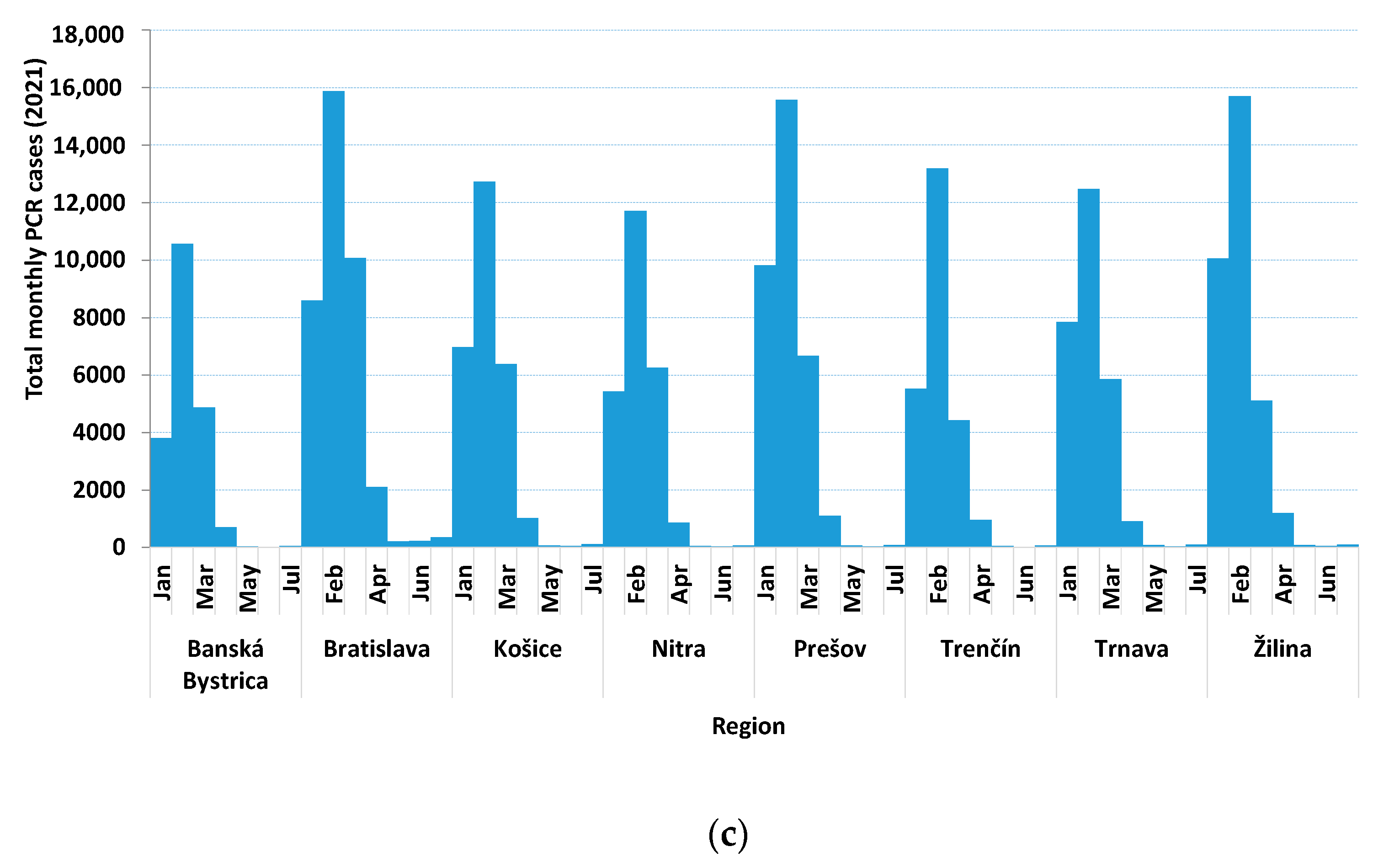
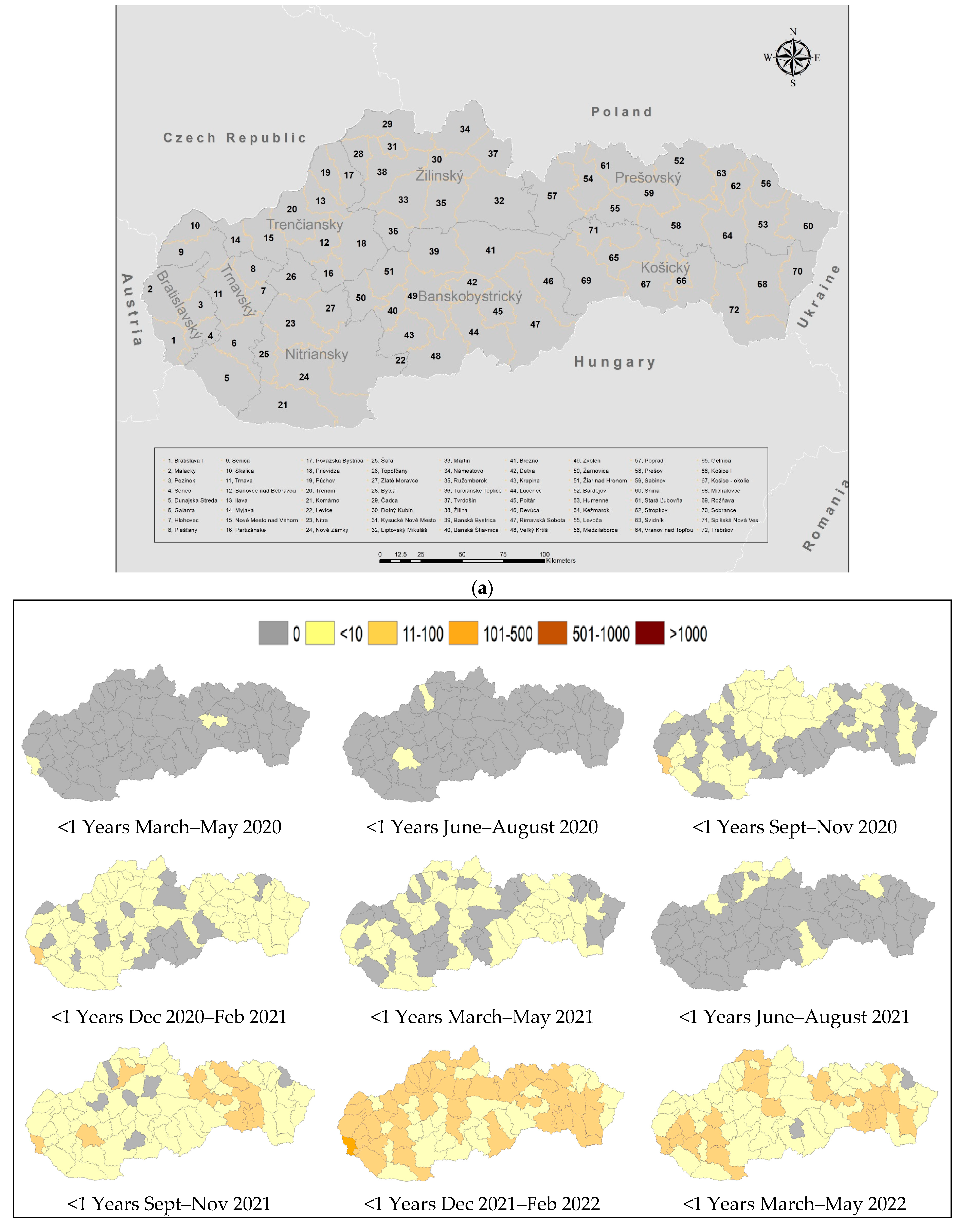
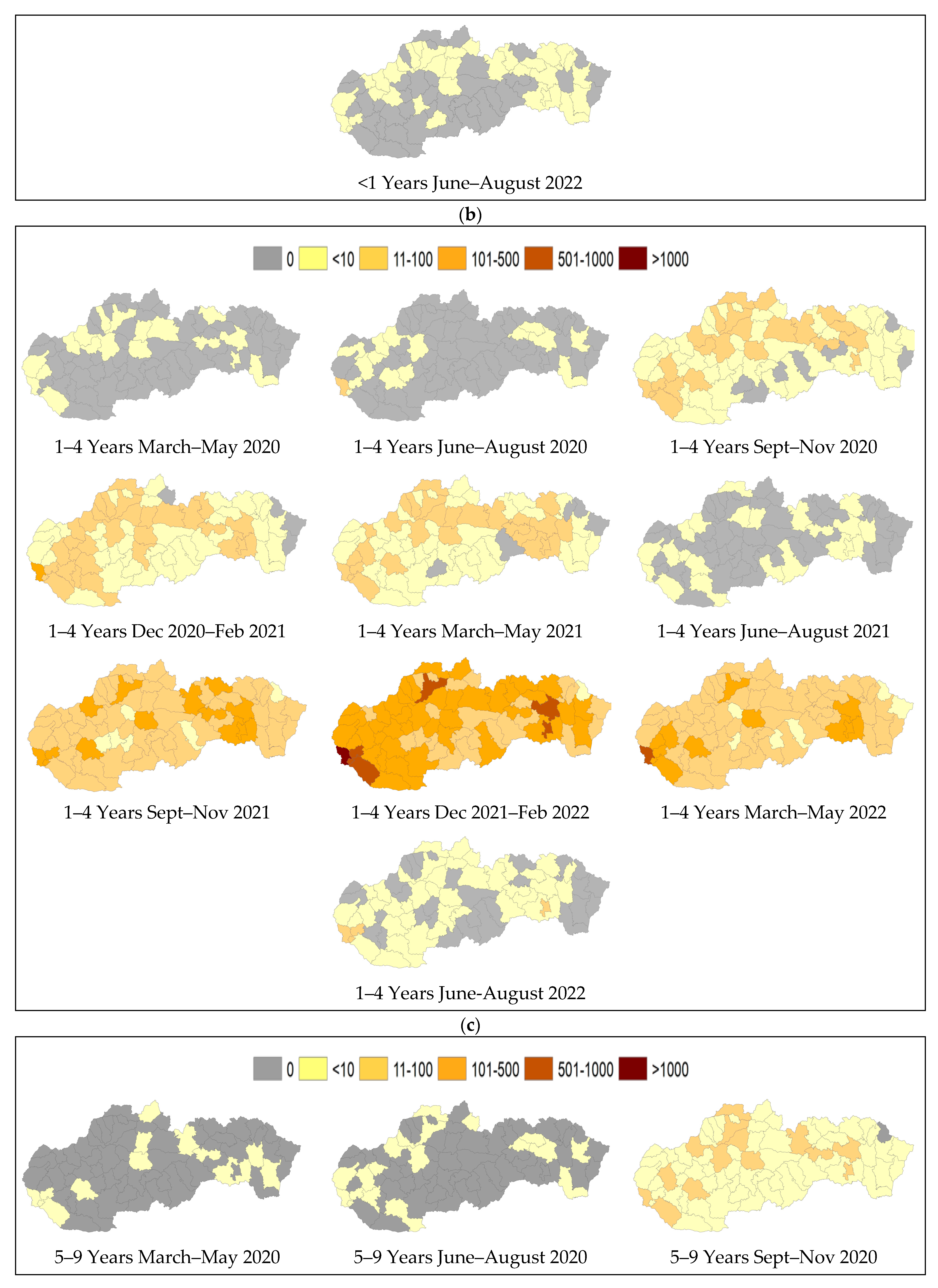
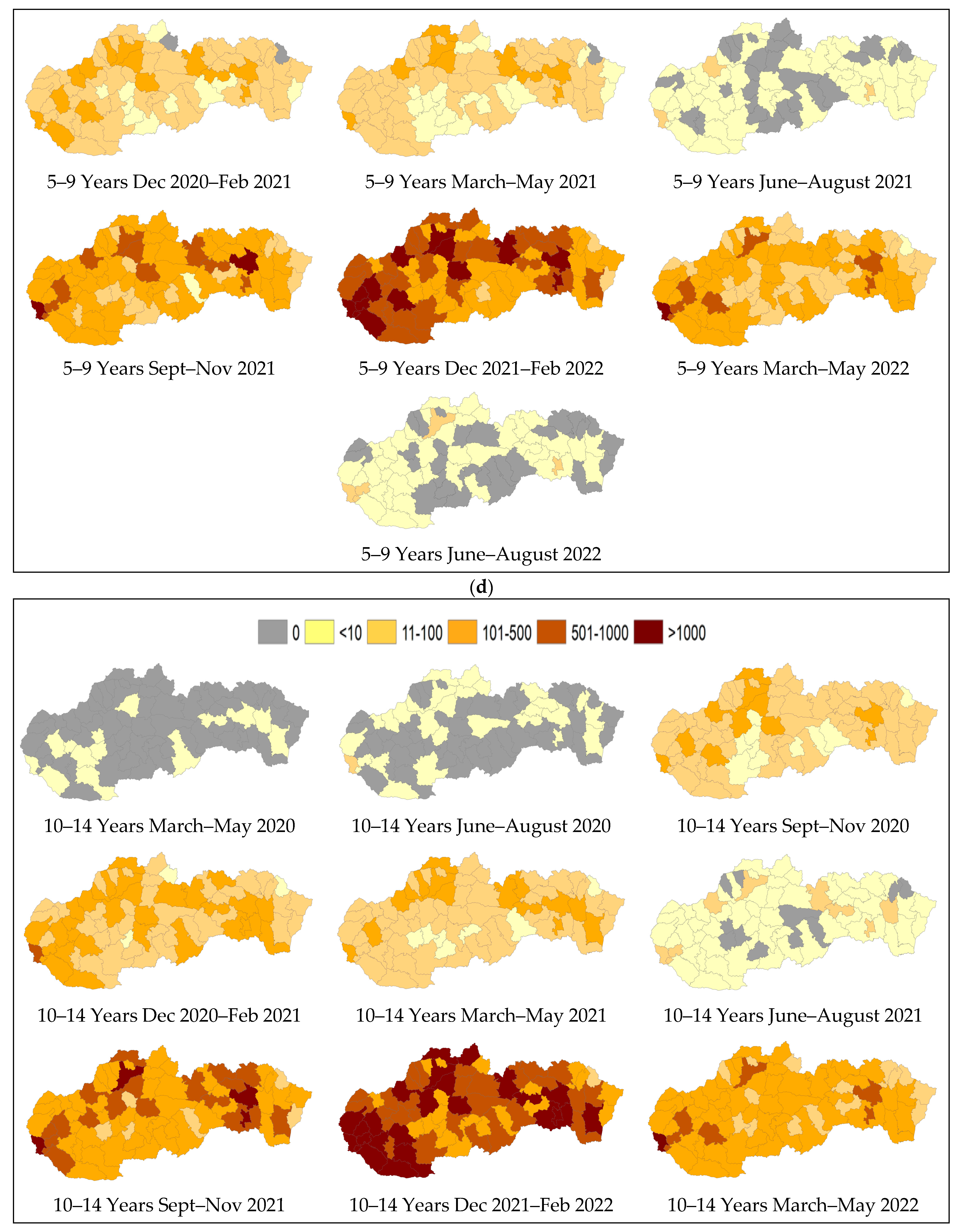
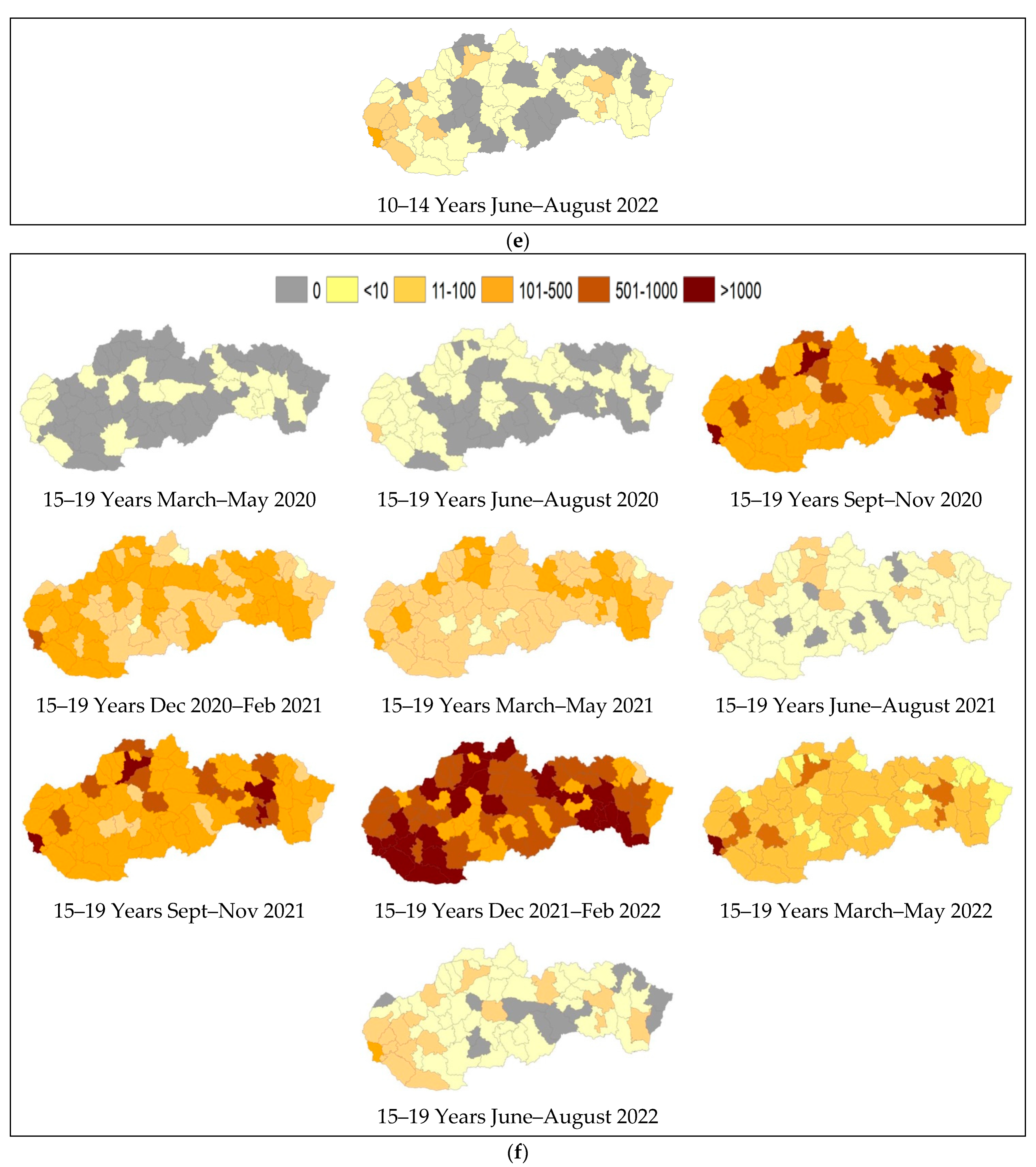
| Region | Case/Pop % | Case/km2 |
|---|---|---|
| Banská Bystrica | 5.8 | 3.91 |
| Bratislava | 8.7 | 28.63 |
| Košice | 6.2 | 7.38 |
| Nitra | 5.5 | 5.85 |
| Prešov | 7.5 | 6.96 |
| Trenčín | 7.7 | 9.93 |
| Trnava | 8 | 10.97 |
| Žilina | 8.4 | 8.58 |
Disclaimer/Publisher’s Note: The statements, opinions and data contained in all publications are solely those of the individual author(s) and contributor(s) and not of MDPI and/or the editor(s). MDPI and/or the editor(s) disclaim responsibility for any injury to people or property resulting from any ideas, methods, instructions or products referred to in the content. |
© 2024 by the authors. Licensee MDPI, Basel, Switzerland. This article is an open access article distributed under the terms and conditions of the Creative Commons Attribution (CC BY) license (https://creativecommons.org/licenses/by/4.0/).
Share and Cite
Gharaibeh, A.; Gharaibeh, M.A.; Bataineh, S.; Kecerová, A.M. Exploring the Spatial and Temporal Patterns of Children and Adolescents with COVID-19 Infections in Slovakia during March 2020 to July 2022. Medicina 2024, 60, 931. https://doi.org/10.3390/medicina60060931
Gharaibeh A, Gharaibeh MA, Bataineh S, Kecerová AM. Exploring the Spatial and Temporal Patterns of Children and Adolescents with COVID-19 Infections in Slovakia during March 2020 to July 2022. Medicina. 2024; 60(6):931. https://doi.org/10.3390/medicina60060931
Chicago/Turabian StyleGharaibeh, Ahmad, Mamoun A. Gharaibeh, Siham Bataineh, and Anna Maria Kecerová. 2024. "Exploring the Spatial and Temporal Patterns of Children and Adolescents with COVID-19 Infections in Slovakia during March 2020 to July 2022" Medicina 60, no. 6: 931. https://doi.org/10.3390/medicina60060931
APA StyleGharaibeh, A., Gharaibeh, M. A., Bataineh, S., & Kecerová, A. M. (2024). Exploring the Spatial and Temporal Patterns of Children and Adolescents with COVID-19 Infections in Slovakia during March 2020 to July 2022. Medicina, 60(6), 931. https://doi.org/10.3390/medicina60060931






